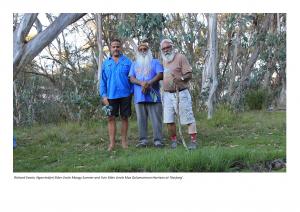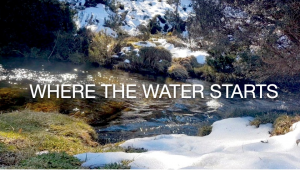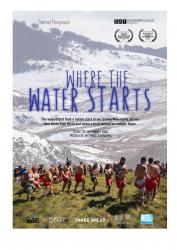Project Overview
In 2020 NED supported Amanda King in engaging an Impact Manager to assist in promoting her film, Where the Water Starts, which launched in 2021.
Amanda worked closely with Yuin Elder, Uncle Max Dulumunmun Harrison and Richard Swain, the Indigenous Ambassador, who holds an honorary role for the Invasive Species Council, to understand the issues relating to brumbies in Kosciuszko National Park. Both the environmental impacts and the way in which the issue affects the Aboriginal Community and their relationship with this site of significant spiritual significance have been considered. The appeal they make is for a limit to be placed on brumbies in the park rather than to remove their presence entirely. The film supports the ongoing work of Richard Swain who continues to campaign.
After seeing the destruction of the fragile alpine ecology of the Snowy Mountains firsthand, Richard Swain with the support of his partner, Alison decided to speak out. The trampling of hard hooved animals is endangering the long-term viability of the headwaters of the Murrumbidgee and the Murray Rivers. Thirty-four native species of plants and mammals are threatened by the impacts of the horse on their unique and sensitive habitat. Richard loves the bush and wildlife of the southern ranges of New South Wales, where he was born. As Indigenous Ambassador for the Invasive Species Council, Richard Swain has taken on a public role.
It is estimated that over 20,000 feral horses in the park are threatening the survival of 23 native plant species and 11 native animal species. Australia's alpine and sub-alpine terrain is extremely small amounting to 0.01 percent of our inhabited continent, the driest one on earth, yet it contributes almost 30% of the Murray-Darling Basin's water. Despite its significance as a water supply feral horses are degrading the headwaters of these major rivers, 'like elephants in stilettos', describing the impacts of feral animals on land, water, and country in Kosciuszko National Park. Yet a state law - The Kosciuszko Wild Horse Heritage Act - continues to protect a feral animal above the native species and environment. It is a challenge he embraces despite a negative and virulent social media campaign, which includes threats against him and Alison. Listed as a national heritage area in 2008 the Australian Alps remains vulnerable, particularly in NSW, because of the legal protection of feral horses.
Host a Virtual Screening:
Create a Screening via FanForce
From the Project Facebook Page:
'Where The Water Starts reveals how the fragile alpine region of Kosciuszko National Park in the Australian Alps is seen by a number of Indigenous and non-Indigenous people who were born or live in the southern mountains or care deeply about it.'
Where the Water Starts Facebook Page
From the Project Website:
Synopsis DURATION: 71 MINUTES
The Snowy Mountains is home to the headwaters of the Snowy, Murray and Murrumbidgee Rivers yet the delicate alpine ecosystem that supports these vital water sources is being trampled.
The alpine area that covers only 0.01 of Australia's inhabited land mass is under threat from a combination of the impacts of feral animals, artificial water flows and climate change. Where The Water Starts reveals how this fragile alpine region, particularly Kosciuszko National Park, the largest in the Australian Alps is seen by a number of Indigenous and non-Indigenous people who were born or live in the southern mountains area, or who care deeply about it.
The film brings together respected Aboriginal community leaders including Uncle Max Dulumunmun Harrison, Aunty Sue Bulger, Aunty Rhonda Casey, Bruce Pascoe as well as alpine river guide, Richard Swain and his partner Alison, and local farmer, Sterling Dixon, scientist, Prof David Watson, former parks officer, Paul Hardey and academic, Dr Isa Menzies. The film reflects on their ideas around caring for country as a shared responsibility of all Australians; that the best of Aboriginal connection and the best of regenerative science can work together for a better future for the alpine environment and to protect the habitats of 34 threatened native species.


